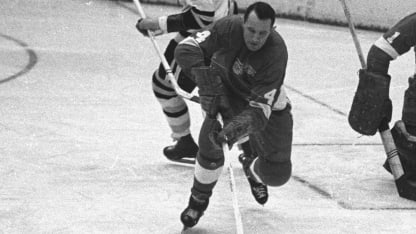Bill Gadsby, the Hockey Hall of Fame defenseman who played 20 seasons for the Chicago Blackhawks, New York Rangers and Detroit Red Wings, died Thursday. He was 88.
Gadsby, who played in the League from 1946 to 1966, was a three-time First-Team All-Star. He had 130 goals and 568 points in 1,248 games.
Hockey Hall of Fame legend Gadsby dies at 88
All-star defenseman played for Red Wings, Blackhawks and Rangers

© B Bennett/Getty Images
By
Brian Hunter @BrianHunterNHL / NHL.com staff writer
We are saddened to learn of the passing of Bill Gadsby, former DRW defenseman & head coach - https://t.co/Lhyt6bUpTM pic.twitter.com/0BLefLtGan
— Detroit Red Wings (@DetroitRedWings) March 10, 2016
The native of Calgary was inducted into the Hockey Hall of Fame in 1970 and was ranked No. 99 in The Hockey News' list of 100 Greatest Hockey Players, released in 1988.
Gadsby was among the toughest players in the League throughout his career, a reputation he earned even before he first stepped on the ice with the Chicago Black Hawks, as they were then known, during the 1946-47 season.
He entered the League already having survived a torpedo attack, nearly being hit with a falling chunk of concrete and defeating a potentially crippling disease.
In 1939, in the dawning days of World War II, a 12-year-old Gadsby and his mother were among those who escaped alive when a German U-boat torpedoed and sunk the English passenger liner Athenia in the Atlantic Ocean, killing 128 people.
Two years later Gadsby came within inches of being struck by what he described as "a huge piece of concrete" that fell four stories from a nearby building and left a large hole in the sidewalk. And early in his playing career he overcame a bout with polio to make the All-Star team just six months later.
Those hardships forged his appreciation for the life he carved out in professional hockey, as a player and later as a coach with the Detroit Red Wings.
"I think being a pro hockey player, especially in the NHL, is a great life," Gadsby told Sports Illustrated in 2002.
Gadsby's 568 points in 1,248 NHL games amounted to prodigious production during an era when players at his position tended to patrol their own blue line while rarely joining the attack.
William Alexander Gadsby was born Aug. 8, 1927, and grew up playing hockey all day and late into the Alberta nights, to the point where his father eventually asked him whether his long-term focus was school or a career playing hockey. His son indicated the latter, and it turned out to be a wise decision.
Gadsby played his junior hockey in Edmonton and was discovered there by the Black Hawks, who paid him more than $10,000 (including a $3,000 signing bonus) in order to bring him into the organization.
After spending all of a dozen games in the minor leagues, Gadsby debuted with Chicago and had eight goals and 18 points in 48 games as a rookie in 1946-47. During his first eight seasons in the League he developed into one of the game's leading defensemen, improving his offensive output to 12 goals and 41 points in 1953-54, which turned out to be his last full season in Chicago.
It wasn't just his talent with the puck or his reliability in the defensive end that came to define Gadsby. It was his rugged style and willingness to put himself in harm's way for the benefit of the team.
"As an athlete I felt as if I owed my coach, my teammates and the fans my best every night," Gadsby once told hockey historian Kevin Shea. "As an athlete I felt I had to stand up for my teammates and myself. As an athlete I felt I couldn't cheat the talent I had been blessed with."
On Nov. 23, 1954, Gadsby was part of a five-player trade between the Black Hawks and Rangers, and his career would take off in New York. Given more opportunity to concentrate on the offensive side of his game, he set a personal NHL high with 51 points in 1955-56, his first full season with the Rangers. Two seasons later he scored a single-season best 14 goals. In 1958-59 he again had 51 points, and his 46 assists set a League record for a defenseman.
By this point, Gadsby also had his face carved up by many errant shots or stick blades, accumulating a significant portion of the more than 640 stitches he needed in his career -- a total estimated by his wife, Edna, who tracked the injuries in a log.
In his NHL debut for the Black Hawks he sustained a cut that required 12 stitches, a harbinger of things to come. At one point, Gadsby took out a $100 insurance policy that was to pay him $5 for each stitch he received during the upcoming season. Not only was it a wise decision, but with his track record it wound up being a lucrative one.
"A few days after I bought the policy, Hugh Bolton of the Maple Leafs fired a shot towards the net," Gadsby told Shea. "Just as he completed his follow-through, [teammate] Bill Mosienko skated in front of me and I never saw the puck until it split open my lower lip.
"The final tally was 30 stitches. It was the ugliest gash of my career. My diet consisted of tea and toast for about three weeks. I lost 11 pounds. But I had to laugh at the poor agent who sold me that stitch insurance. In less than two weeks I had paid for the policy. I had gotten back all my money, plus a $50 profit. I think they stopped offering that policy not long after that."
While Gadsby was racking up everything from stitches to points and All-Star appearances through the first two-thirds of his career, postseason games were few and far between. He made it to the Stanley Cup Playoffs once with the Black Hawks and three times with the Rangers but his teams never won a series.
That changed after he was traded to the Red Wings prior to the start of the 1961-62 season. The Red Wings previously had tried to acquire Gadsby; a previous trade attempt between the Rangers and Red Wings late in the 1959-60 season had fallen through when two of the players the Red Wings planned to send to the Rangers refused to report. But Red Wings general manager Jack Adams kept Gadsby on his radar and eventually got his man.
"Coming to Detroit, I thought it was going to be a chance to win it all," Gadsby said. "We had some tremendous teams."
Although Gadsby's offensive production gradually declined during his five seasons in Detroit, he remained a force on the back end. And for the first time he had an opportunity to play on a team with the chance of winning the Stanley Cup.
The Red Wings reached the Stanley Cup Final three times in his final four NHL seasons but lost to the Toronto Maple Leafs in 1963 and 1964 and to the Montreal Canadiens in 1966.
Gadsby retired after the 1966 Final.
"You can't dwell on the disappointment," Gadsby said later. "I had a wonderful career and got to play with some great players."
Gadsby was the first NHL defenseman with 500 points and the first player to skate in at least 300 games for three teams.
After his playing career finished Gadsby spent parts of two seasons coaching the Red Wings, going 35-31-12 in 78 games and later worked at a friend's crane-rental company in Detroit before retiring in 1986. An "Honored Member" of the Red Wings' Alumni Association, Gadsby remained active in helping raise money for children's charities in the Detroit area.
He is survived by Edna, his wife of more than 60 years; their daughters Brenda, Judy, Donna and Sandy; and several grandchildren and great-grandchildren.

















